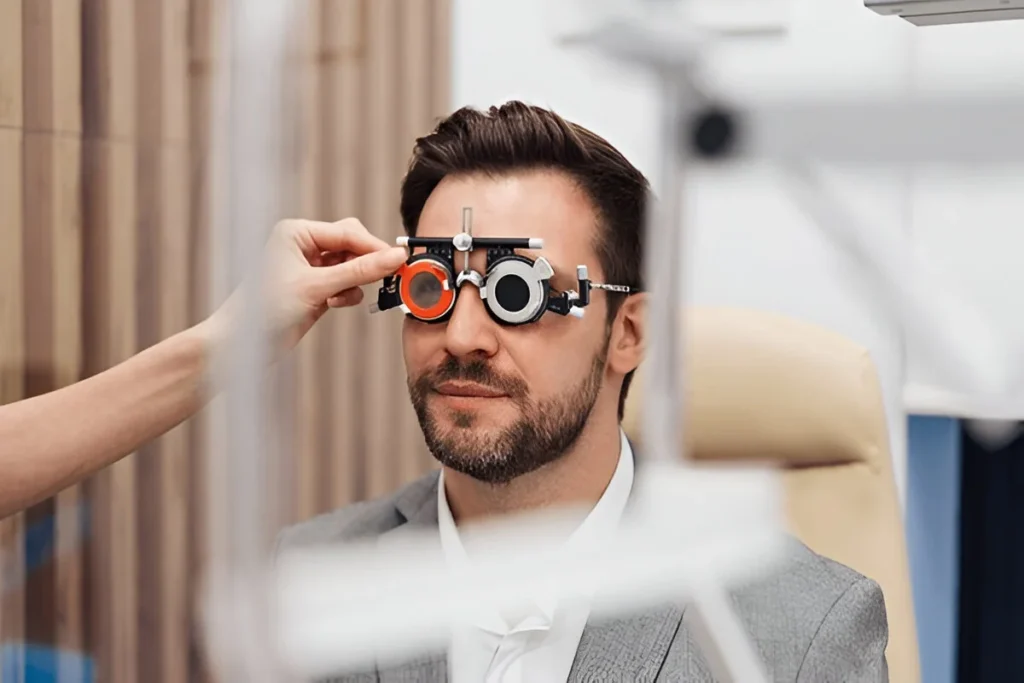Cataracts in young adults Learn the causes, symptoms, and prevention strategies with insights from a reputed eye surgeon.
Understanding Cataracts Beyond Old Age
When people hear the word “cataract,” they often imagine it as an inevitable part of aging. While cataracts are more common in older adults, an increasing number of cases now occur in younger individuals. This condition, often overlooked, can disrupt education, careers, and quality of life for people in their 20s, 30s, or 40s.
Recognizing the causes and risk factors is the first step to protecting long-term vision health. With timely diagnosis and appropriate treatment, young adults can continue to lead normal, fulfilling lives.

What Are Cataracts
A cataract occurs when the clear lens of the eye becomes cloudy, leading to blurred or hazy vision. In healthy eyes, the lens focuses light sharply onto the retina. When a cataract develops, light scattering and clouding interfere with clear sight.
Cataracts usually progress slowly, but in younger adults, they can be aggressive and impact daily life more quickly.
Causes of Cataracts in Young Adults
While aging is the most common trigger, several factors explain why cataracts can develop much earlier.
Genetic Factors
- Family history can predispose some individuals to early cataract formation.
- Certain inherited conditions, such as metabolic disorders, increase the likelihood of clouded lenses.
Eye Injuries
- Trauma to the eye—even minor accidents—can trigger cataract development.
- Sports injuries or workplace hazards are frequent causes in younger populations.
Medical Conditions
- Diabetes is one of the most significant risk factors. High blood sugar can cause lens swelling and protein changes.
- Thyroid imbalance and autoimmune disorders may also contribute.
Lifestyle Influences
- Prolonged screen exposure has been linked to oxidative stress in the eyes.
- Smoking and alcohol accelerate lens damage.
- Poor diet lacking antioxidants may reduce the eye’s natural defense mechanisms.
Medications and Treatments
- Long-term use of corticosteroids can increase cataract risk.
- Some cancer treatments or radiation exposure may also play a role.
Environmental Factors
- Excessive UV exposure from sunlight can damage lens proteins.
- Pollution and occupational chemical exposure are growing contributors.
Signs and Symptoms to Watch For
Young adults should not dismiss subtle vision changes. Early warning signs include:
- Blurred or cloudy vision
- Glare sensitivity, especially while driving at night
- Difficulty reading in low light
- Colors appearing faded or yellowish
- Frequent changes in eyeglass prescriptions

Impact of Cataracts in Younger People
Cataracts can disrupt professional, academic, and social life. Unlike older adults who may adjust their pace, young individuals often face higher functional demands at work or study. Delayed treatment can mean:
- Reduced productivity and performance
- Psychological stress due to vision limitations
- Increased risk of accidents, particularly while driving
- Limitations in pursuing certain careers
Diagnosing Cataracts in Young Adults
Diagnosis usually involves a comprehensive eye exam that includes:
- Visual acuity testing
- Slit lamp examination to view the lens
- Retinal evaluation to rule out additional eye conditions
Prompt detection allows for tailored treatment before the cataract significantly impacts quality of life.
How Cataracts in Young Adults Can Be Managed
While prevention is the ideal goal, management strategies vary depending on severity.
- Early stages: Improved lighting, anti-glare glasses, and lifestyle changes may help.
- Progressive cataracts: Surgery remains the most effective option, replacing the cloudy lens with a clear artificial one.
Prevention Tips for Young Adults
Though not all cataracts can be avoided, certain practices lower the risk:
- Wear sunglasses with UV protection.
- Quit smoking and limit alcohol.
- Maintain blood sugar levels if diabetic.
- Eat a diet rich in antioxidants (leafy greens, berries, nuts).
- Schedule regular eye check-ups.

FAQs
Can cataracts be reversed without surgery?
No. While lifestyle changes may slow progression, surgery is the only way to remove cataracts once they form.
Are cataracts painful?
Most cataracts are painless, though they can cause visual discomfort and glare sensitivity.
Can children or teenagers get cataracts?
Yes. Some are born with congenital cataracts, while others may develop them due to injury or medical conditions.
Is cataract surgery safe for young adults?
Yes. Modern surgical techniques are highly effective, offering quick recovery and long-term clarity.
Do digital devices cause cataracts?
Screen time doesn’t directly cause cataracts but may worsen oxidative stress, indirectly contributing to lens damage over time.
Importance of Expert Guidance
While cataracts may sound daunting at a young age, proper medical guidance ensures the best outcomes. The expertise of the Best Eye Surgeon in Kolkata can make a significant difference by providing accurate diagnosis, tailored treatment options, and long-term vision care strategies.
Clear Vision Today Shapes a Brighter Tomorrow
Cataracts in younger adults may be surprising, but awareness is the strongest shield against their impact. By understanding causes, recognizing early signs, and seeking expert guidance at the right time, young individuals can protect their vision for decades to come. Eye health is not only about seeing well—it’s about living fully, confidently, and without limits.

